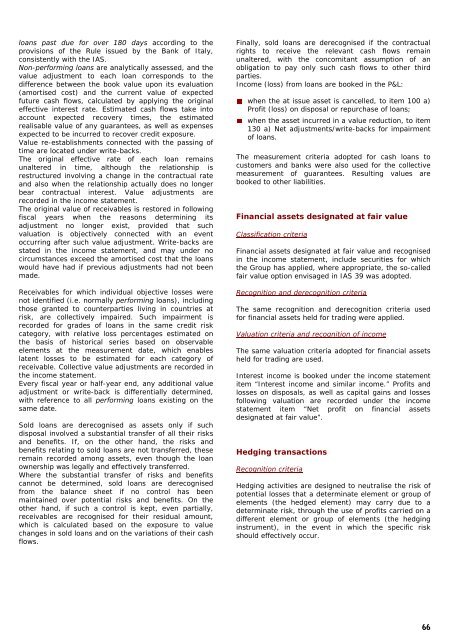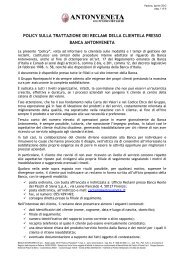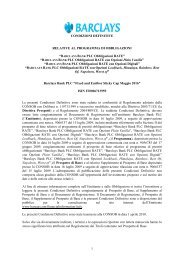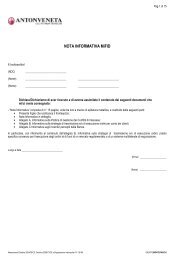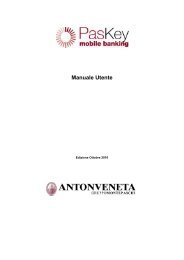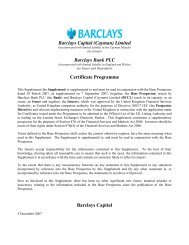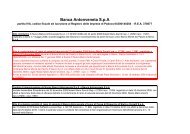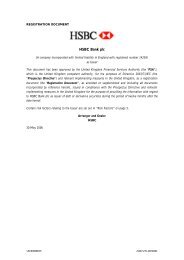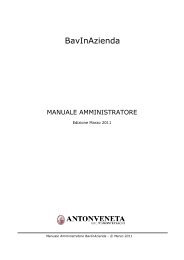996 - Banca Antonveneta
996 - Banca Antonveneta
996 - Banca Antonveneta
You also want an ePaper? Increase the reach of your titles
YUMPU automatically turns print PDFs into web optimized ePapers that Google loves.
loans past due for over 180 days according to theprovisions of the Rule issued by the Bank of Italy,consistently with the IAS.Non-performing loans are analytically assessed, and thevalue adjustment to each loan corresponds to thedifference between the book value upon its evaluation(amortised cost) and the current value of expectedfuture cash flows, calculated by applying the originaleffective interest rate. Estimated cash flows take intoaccount expected recovery times, the estimatedrealisable value of any guarantees, as well as expensesexpected to be incurred to recover credit exposure.Value re-establishments connected with the passing oftime are located under write-backs.The original effective rate of each loan remainsunaltered in time, although the relationship isrestructured involving a change in the contractual rateand also when the relationship actually does no longerbear contractual interest. Value adjustments arerecorded in the income statement.The original value of receivables is restored in followingfiscal years when the reasons determining itsadjustment no longer exist, provided that suchvaluation is objectively connected with an eventoccurring after such value adjustment. Write-backs arestated in the income statement, and may under nocircumstances exceed the amortised cost that the loanswould have had if previous adjustments had not beenmade.Receivables for which individual objective losses werenot identified (i.e. normally performing loans), includingthose granted to counterparties living in countries atrisk, are collectively impaired. Such impairment isrecorded for grades of loans in the same credit riskcategory, with relative loss percentages estimated onthe basis of historical series based on observableelements at the measurement date, which enableslatent losses to be estimated for each category ofreceivable. Collective value adjustments are recorded inthe income statement.Every fiscal year or half-year end, any additional valueadjustment or write-back is differentially determined,with reference to all performing loans existing on thesame date.Sold loans are derecognised as assets only if suchdisposal involved a substantial transfer of all their risksand benefits. If, on the other hand, the risks andbenefits relating to sold loans are not transferred, theseremain recorded among assets, even though the loanownership was legally and effectively transferred.Where the substantial transfer of risks and benefitscannot be determined, sold loans are derecognisedfrom the balance sheet if no control has beenmaintained over potential risks and benefits. On theother hand, if such a control is kept, even partially,receivables are recognised for their residual amount,which is calculated based on the exposure to valuechanges in sold loans and on the variations of their cashflows.Finally, sold loans are derecognised if the contractualrights to receive the relevant cash flows remainunaltered, with the concomitant assumption of anobligation to pay only such cash flows to other thirdparties.Income (loss) from loans are booked in the P&L:when the at issue asset is cancelled, to item 100 a)Profit (loss) on disposal or repurchase of loans;when the asset incurred in a value reduction, to item130 a) Net adjustments/write-backs for impairmentof loans.The measurement criteria adopted for cash loans tocustomers and banks were also used for the collectivemeasurement of guarantees. Resulting values arebooked to other liabilities.Financial assets designated at fair valueClassification criteriaFinancial assets designated at fair value and recognisedin the income statement, include securities for whichthe Group has applied, where appropriate, the so-calledfair value option envisaged in IAS 39 was adopted.Recognition and derecognition criteriaThe same recognition and derecognition criteria usedfor financial assets held for trading were applied.Valuation criteria and recognition of incomeThe same valuation criteria adopted for financial assetsheld for trading are used.Interest income is booked under the income statementitem “Interest income and similar income.” Profits andlosses on disposals, as well as capital gains and lossesfollowing valuation are recorded under the incomestatement item “Net profit on financial assetsdesignated at fair value”.Hedging transactionsRecognition criteriaHedging activities are designed to neutralise the risk ofpotential losses that a determinate element or group ofelements (the hedged element) may carry due to adeterminate risk, through the use of profits carried on adifferent element or group of elements (the hedginginstrument), in the event in which the specific riskshould effectively occur.66


